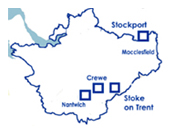Massage
What is Massage?
Massage is an enjoyable and relaxing hands-on treatment, which promotes health and well-being, and most importantly promotes the healing process. All treatments are tailored to the individual's requirements.
Massage restores mobility to injured muscle tissue, enhances the performance, and generally maintains the body in better condition. Massage therefore helps to extend the overall life of a person's sporting career!
Sports/Deep Tissue Massage
This is a style of massage where the therapist applies strong pressure, using slow and deep strokes on parts of the body where muscles are tight and knotted. The pressure and movement is varied with the use of the therapist's hands, forearms and fingers. Friction across the muscle grain is also used to release chronic muscle tension. This technique is particularly effective in patients with muscle overuse issues and in the management of sports people. Trigger point massage uses deeper more focused pressure on trigger points (Knots) that form within the muscles. Overall massage therapy is used to increase the circulation of blood/oxygen to the area being massaged, bringing warmth and reducing pain.
Reasons to Treat Yourself to a Massage
- Tension around neck and shoulders
- Headaches
- Lower back pain
- Tight hamstrings
- Relaxation
- Preparation or recovery from a marathon or sporting activity
Physical Effects of Massage
Increases Tissue Permeability
Deep massage helps remove waste products such as Lactic Acid, encouraging muscles to take up oxygen and fresh nutrients to help them recover quicker. It strengthens the immune system and helps prevent injuries.
Stretching
Massage can help stretch bundles of muscle fibres, both lengthways and sideways, so releasing any tension or pressure build-up. Tension build-up is especially common in individuals with office based jobs where back, neck and shoulder problems are prevalent.
Break down of Scar Tissue
Scar tissue is the result of previous injuries and can affect muscles, ligaments and tendons. This can lead to inflexible tissues that are further prone to injury and pain.
Improves Tissue Elasticity
Intensive training can make muscles hard and inelastic and therefore inefficient. Improvements are less likely and injuries almost inevitable. Massage helps reverse this process by increased circulation and stretching the tissues.
Opens Micro-Circulation
Massage increases blood flow to tissues dilating the blood vessels, enabling nutrients to pass through more easily. Conversely, a tight muscle deprives the tissues of vital nutrients and energy to repair.
Relaxation/Stress Relief
Tired or overworked muscles in the neck and shoulders can lead to fibrosis in the muscles as the fibres become knotted. This build up of tension, leads to headaches, back pain, tingling joints and a feeling of general lethargy. Massage causes muscles to relax through heat generation, increased circulation and stretching of tissues.
Also helps reduce fatigue.


